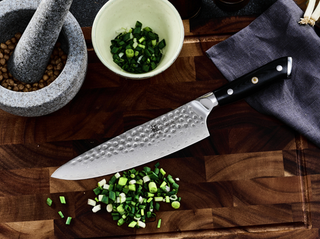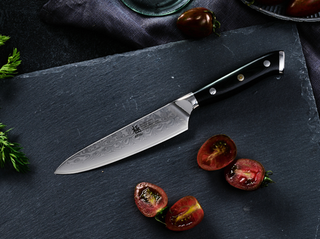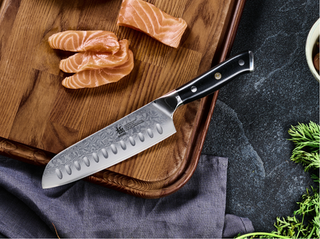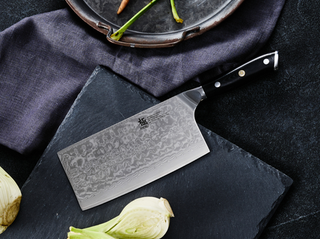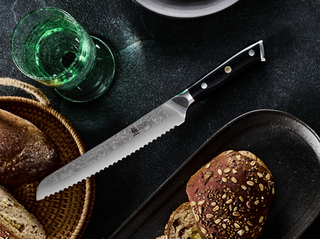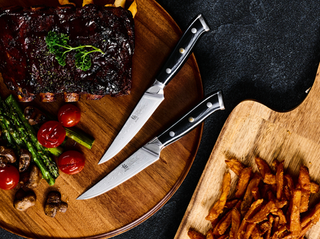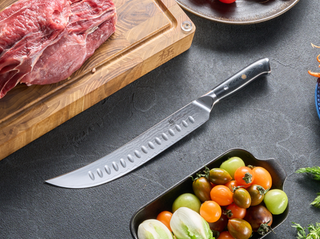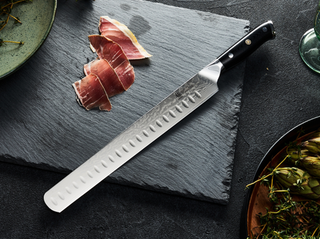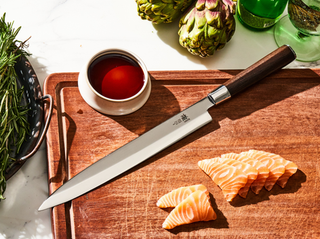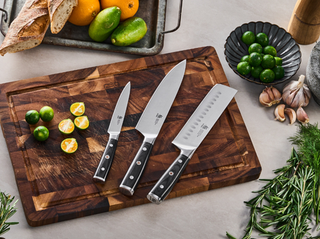Introduction
Having the right tools in the kitchen not only enhances the cooking experience but also elevates the quality of the food prepared. Japanese knives have become the most highly coveted culinary tools for many reasons including their meticulous craftsmanship and cutting-edge design. This guide will explore three popular Japanese knife styles—Nakiri knife style, Santoku knife style, and Kiritsuke knife style—each known for its unique capabilities and suited for different tasks in the kitchen.
What are the Different Styles of Japanese Knives?
Let’s start with the Japanese knife styles that are most commonly used, and then continue with the three popular Japanese knife styles—Nakiri knife style, Santoku knife style, and Kiritsuke knife style. The following are some types of Japanese knives that are most commonly used:
- Nakiri (vegetable knife)
- Santoku (multi-purpose knife)
- Kiritsuke (multi-purpose knife)
- Petty (utility knife)
- Deba (butcher's knife)
- Yanagi (sushi knife)
- Gyuto (chef's knife)
- Honesuki (boning knife)
- Sujihiki (carving knife)
- Usuba (vegetable knife)
- Takobiki (slicing knife)
- Pankiri (serrated knife)
- Mukimono (paring and garnish knife)
- Udon kiri (udon noodle knife)
Nakiri Knives - Your Vegetable Expert
Nakiri knives are designed specifically for cutting vegetables. With their straight blade, Nakiri knives can deliver clean cuts through vegetables without damaging delicate fibers.
Characteristics and Uses:
- Blade Design: A Nakiri knife usually has a straight blade and squared-off tip, which is perfect for slicing and dicing vegetables. The typical length of a Nakiri knife's blade is usually about 5 to 7 inches.
- Best Uses: Ideal for achieving precise cuts and thin slices, Nakiri knives are best used for preparing vegetables, where accuracy and delicacy are considered.
Kyoku’s Nakiri Knives
"Kyoku" is a heavily established brand that has become known for providing knives with superior craftsmanship and durability. Here is one model of Japanese Nakiri knives from Kyoku that you can look for. This 7-inch Nakiri knife of the Daimyo series is made from vacuum heat-treated Japanese 440C stainless steel, providing outstanding durability and performance. The knife's scalpel-like edge also ensures precise cuts, while its rosewood handle can offer both comfort and balance.
Santoku Knives - The Versatile All-Rounder
Santoku knives represent a design concept that combines traditional Japanese craftsmanship with the requirements of a modern kitchen. They are frequently praised as the best multitaskers in the kitchen. The term "Santoku" can be translated into "three virtues" or "three uses," which aptly captures the flexibility of this knife in its ability to effortlessly slice, dice, and mince.
Characteristics and Uses:
Blade Design: The blade of a Santoku Knife is usually made from high-carbon steel for sharpness and edge retention or from stainless steel for durability and rust resistance. Some models also use Damascus steel, which is known for its strength, durability, and beautifully patterned designs. The length of a Santoku Knife generally ranges from 5 to 7 inches long and there are usually some indentations along the blade to reduce the sticking of food to the blade.
Best Uses in the Kitchen: Santoku knives are especially useful for:- Slicing: The thin and sharp blade can make it excellent for slicing vegetables, cheese, and fruit with precision and minimal effort.
- Dicing: A Santoku knife can make quick work of dicing onions, peppers, and other staples into consistent, small pieces for uniform cooking.
- Mincing: A Santoku knife is ideal for mincing garlic, herbs, and other small ingredients.
Top Santoku Knives from Kyoku
If you are looking for a good Santoku knife now, here is one high-quality model from Kyoku that would be the ideal choice for you. This Santoku knife of the Shogun series is impeccably crafted from 67 layers of stainless Damascus steel, providing a blade that is exceptionally sharp and durable. It also features a sophisticated herringbone pattern that elevates its visual appeal. Furthermore, the blade includes strategically placed indentations that not only enhance its aesthetics but also minimize food sticking.
Kiritsuke Knives - The Versatile Hero
Kiritsuke knives, a staple in many professional kitchens, are excellent for their versatility as they combine the best features of a chef's knife and a vegetable knife. Its design makes it a multifunctional tool that can tackle a wide array of tasks, from precise vegetable cutting to adeptly handling meat.
Characteristics and Uses:
Blade Design: Kiritsuke knives can be made from high-quality steels such as VG-10 or AUS-10 for stainless options. They can also be made of high-carbon steel for those preferring traditional materials. A Kiritsuke knife can be a hybrid single-bevel knife intended for preparing fish and vegetables. Nowadays, it also developed a double-bevel form, which makes it versatile to perform many of the tasks in the kitchen.Best Uses in the Kitchen: Kiritsuke knives are particularly effective for:
- Cutting Vegetables: The Kiritsuke knife has the feature of Yanagiba-a straighter edge, which makes it useful in cutting vegetables.
- Slice Fish with Ease: The length and weight of the blade make it ideal for slicing fish with ease, similar to Usuba.
Popular Kiritsuke Knife from Kyoku
Kyoku has Kiritsuke knives that are outstanding on the market. There is one model that you can look for. This Kiritsuke Knife of the Shogun Series is crafted with cryogenically treated Damascus steel for peerless durability and performance. Ideal for a variety of culinary tasks—from slicing and carving to chopping and dicing—this versatile tool excels in many kitchen tasks.
Caring for Your Japanese Knives
After learning three Japanese knife styles, you may now know what Japanese knife best suits your needs. When you get your ideal Japanese knife, no matter what Japanese knife style to buy, it is important to know some care tips for your Japanese knives. Proper maintenance is key to preserving the longevity and performance of your Japanese knives.
Basic Maintenance Tips:
- Cleaning: Always clean your knife immediately after use to prevent food acids from damaging the blade. Use mild soap and water and dry it thoroughly.
- Sharpening: Regular honing before or after each use will keep the blade sharp. Using a whetstone or ceramic sharpener as metal hones may be too harsh for the fine edge of a Japanese knife.
- Storage: Store your knives in a wooden block or on a magnetic knife strip to prevent the edges from dulling. Avoid jumbled drawers where blades may get damaged.
Do's and Don'ts:
- Do regularly apply mineral oil to the handle and the blade to maintain its finish and prevent drying or cracking.
- Don't put your knives in the dishwasher. The harsh chemicals and heat can damage the steel and the handle.
Conclusion
Throughout this exploration of Nakiri knives, Santoku knives, and Kiritsuke knives, this guide has delved into what makes each style unique and suited for specific tasks in the kitchen. Whether you are a professional chef or a home cooking enthusiast, considering your cooking style and needs when choosing a knife will help you make the most of these finely crafted tools. For outstanding Nakiri knives, Santoku knives, Kiritsuke knives, or more Japanese knife styles, visit Kyoku to embrace the quality and precision of Japanese craftsmanship and enhance your cooking skills!
